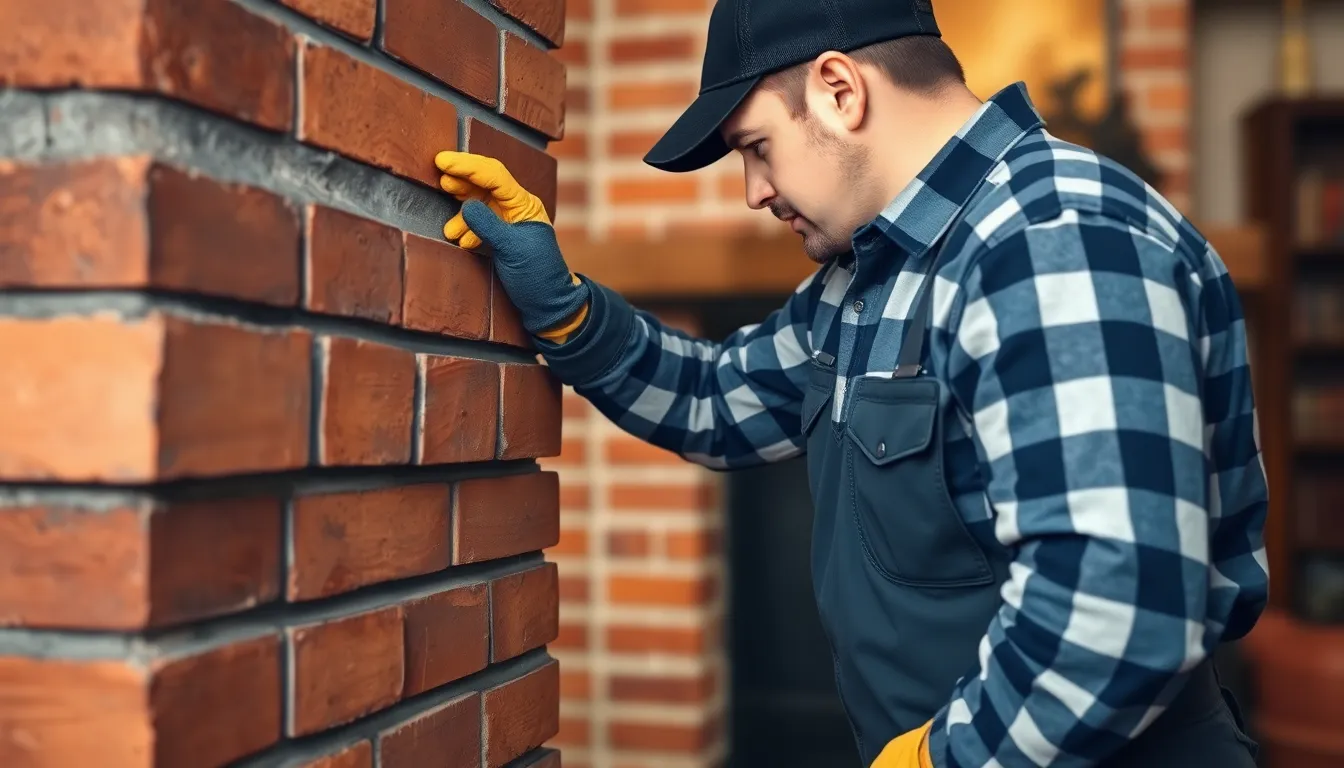Table of Contents
ToggleWhen was the last time a chimney sweep crossed your mind? If it’s been a while, you’re not alone. Many homeowners overlook this crucial task, thinking it’s just a relic from Mary Poppins. But let’s face it—nobody wants their cozy fireplace turning into a smoke-filled sauna. Regular chimney sweeping isn’t just about keeping up appearances; it’s about safety and efficiency.
Overview of Chimney Sweeping
Chimney sweeping serves an essential role in home safety and efficiency. This process removes soot, debris, and creosote, which can accumulate in the chimney and pose fire hazards. Regular cleaning prevents smoke from backing up into the home, significantly enhancing indoor air quality.
The National Fire Protection Association recommends scheduling inspections and sweeps at least once a year, especially for wood-burning appliances. Homeowners must also consider factors like frequency of use and the type of fuel used. Gas appliances may require less frequent attention compared to wood-burning stoves.
Tools used in chimney sweeping include brushes, rods, and vacuums, all designed for effective cleaning. Professionals typically utilize rotary brushes to ensure thorough removal of buildup. Some may even use video inspection equipment to assess the condition of the chimney lining, identifying any potential issues.
Hiring a certified chimney sweep ensures that the job is completed according to industry standards. Certified professionals possess the training necessary to identify problems that might go unnoticed by untrained eyes, such as structural damage or flue blockages.
Regular chimney sweeping not only extends the life of the chimney but also increases the efficiency of the fireplace. Increased efficiency translates to reduced heating costs, benefiting homeowners financially. Neglecting this maintenance can lead to costly repairs, dangerous fires, or even smoke damage.
Understanding the importance of chimney sweeping empowers homeowners to take proactive steps in maintaining their fireplaces. Establishing a cleaning schedule and addressing issues promptly contributes to a safer home environment.
Importance of Chimney Sweeping

Chimney sweeping plays a crucial role in maintaining home safety and efficiency. Regular sweeping prevents hazardous conditions that could endanger occupants.
Fire Safety
Fire safety relies heavily on regular chimney maintenance. Soot and creosote buildup create significant fire risks, potentially causing dangerous chimney fires. According to the National Fire Protection Association, thousands of home fires annually result from neglected chimneys. Homeowners must schedule yearly inspections and sweeps, especially for wood-burning appliances. Certified professionals possess the expertise to identify structural damage and blockages that can lead to hazardous situations. Selecting a qualified chimney sweep for comprehensive cleaning drastically reduces the chances of chimney-related fires.
Energy Efficiency
Energy efficiency benefits significantly from routine chimney sweeping. A clean chimney ensures proper airflow, allowing fireplaces to operate at their best. When airflow becomes obstructed by soot or debris, it can lead to inefficient burning and increased energy costs. Fixing airflow issues through regular sweeping leads to optimal combustion, resulting in lower heating expenses. Reports indicate that homeowners who maintain their chimneys can see reduced energy bills by up to 30 percent. Prioritizing chimney maintenance extends the life of the fireplace and contributes to cost-effective home heating.
Types of Chimney Sweeping
Chimney sweeping encompasses various methods, each essential for maintaining chimney safety and efficiency. Two common techniques include manual and mechanical sweeping.
Manual Sweeping
Manual sweeping involves using handheld brushes and rods to clean chimney flues. Technicians insert brushes into the flue and scrub against soot and creosote deposits, effectively dislodging buildup. This method allows for thorough cleaning in areas where mechanized tools may not reach easily. Manual sweeping typically requires skilled professionals, as they must navigate the chimney’s structure and ensure no debris escapes into the home. Homeowners often prefer this approach for its direct interaction and visible results. Regular manual sweeping contributes significantly to reducing the risk of chimney fires, maintaining airflow, and improving heating efficiency.
Mechanical Sweeping
Mechanical sweeping employs electric or rotary brushes to clean chimney interiors efficiently. Professionals utilize specialized equipment that spins brushes rapidly, ensuring a comprehensive removal of soot and creosote. This method can reach higher velocities, leading to faster cleaning processes than manual techniques alone. Although mechanical sweeping may cover larger areas effectively, technicians must assess the chimney condition beforehand. Inspecting the structure prevents damage during the cleaning process. Many homeowners appreciate the thorough nature of mechanical cleaning, often resulting in enhanced airflow and reduced risk of blockages, which can lead to dangerous situations.
Techniques and Tools Used
Chimney sweeping involves specific techniques and tools to ensure thorough cleaning and maintenance. Understanding these tools enhances the effectiveness of chimney care.
Brushes and Equipment
Various brushes and equipment aid in the chimney sweeping process. Professionals typically use nylon or wire brushes to tackle soot and creosote buildup effectively. Specific tools feature flexible rods, which help reach challenging angles in the chimney flue. Specialized vacuums equipped with HEPA filters capture fine debris, preventing it from entering the home during the cleaning process. Many sweeps also incorporate cameras to inspect the chimney’s condition, identifying any cracks or obstructions. These tools play a crucial role in maintaining both safety and efficiency.
Techniques for Different Chimney Types
Different chimney types require tailored techniques for effective cleaning. Manual sweeping works well for traditional masonry chimneys, enabling operators to navigate tight corners with handheld brushes and rods. Mechanical sweeping, utilizing rotary brushes, serves best for metal chimneys, quickly covering larger areas and enhancing airflow. Gas fireplaces, while less prone to soot buildup, still benefit from periodic checks and maintenance to ensure optimal operation. Adapting these techniques based on chimney type maximizes safety and performance throughout the year.
Benefits of Regular Chimney Sweeping
Regular chimney sweeping offers numerous benefits, enhancing both safety and efficiency in homes. Enhancing indoor air quality occurs through the removal of soot and debris, preventing harmful smoke from entering living spaces. Improved airflow significantly contributes to the optimal operation of fireplaces, allowing for better fuel burning.
Lower heating costs result from maintaining a clean chimney. Homeowners can experience reductions in energy bills by up to 30 percent, making this maintenance task financially rewarding. Increased fireplace efficiency means reduced energy consumption, which helps save money over time.
Fire hazards decrease with consistent chimney cleaning. Soot and creosote buildup can ignite, posing a serious risk. The National Fire Protection Association advises scheduling regular inspections, emphasizing that proper maintenance can prevent dangerous incidents in homes.
Regular sweeping extends the lifespan of chimneys, minimizing the need for costly repairs. Identifying potential issues early allows for timely interventions, ensuring that small problems don’t turn into major expenses. This proactive approach contributes to a safer environment and peace of mind for homeowners.
High-quality tools and techniques enhance the effectiveness of sweeps. Professionals typically use nylon or wire brushes, flexible rods, and specialized vacuums fitted with HEPA filters. Adaptation of methods for different chimney types, such as traditional masonry and metal constructions, ensures optimal results.
Regular chimney servicing is crucial, even for gas fireplaces. Although they experience less soot accumulation, routine inspections still provide valuable benefits. By prioritizing chimney maintenance, homeowners create a safer, more efficient home atmosphere.
Regular chimney sweeping is crucial for maintaining a safe and efficient home environment. By prioritizing this essential task, homeowners can significantly reduce fire hazards and improve indoor air quality. The benefits extend beyond safety to include enhanced fireplace performance and lower energy costs.
Investing in professional chimney sweeping ensures that potential issues are identified and addressed promptly. With the right tools and techniques, both manual and mechanical methods can effectively keep chimneys clear of dangerous buildup. Homeowners who embrace routine maintenance not only protect their families but also enjoy a more cost-effective heating solution. Taking proactive steps in chimney care fosters a safer and more comfortable living space for everyone.




